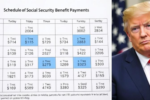The Social Security Fairness Act, a piece of legislation aimed at addressing long-standing inequities in Social Security benefits, has garnered widespread attention. While the act promises to increase benefits for retirees and public sector workers impacted by existing provisions, its implementation is far from straightforward. Advocates for the act and government officials alike are now grappling with the complexities of enacting these changes.
Understanding the Social Security Fairness Act
The Social Security Fairness Act focuses on repealing two controversial provisions: the Windfall Elimination Provision (WEP) and the Government Pension Offset (GPO). Both policies have historically reduced Social Security benefits for public sector workers, including teachers, firefighters, and police officers, who also receive pensions from non-Social Security-covered employment.
The WEP reduces Social Security benefits for retirees who qualify for both a pension and Social Security. Similarly, the GPO decreases spousal or survivor benefits for individuals who receive a government pension. The repeal of these provisions aims to provide equitable benefits to affected retirees, many of whom have faced financial hardships due to the reductions.
Implementation Hurdles
- Complex Benefit Adjustments Implementing the Fairness Act would require recalculating benefits for millions of retirees. The Social Security Administration (SSA) would need to update its systems to remove the WEP and GPO penalties, a process that involves analyzing decades of earnings and benefit data. This recalibration would be a time-intensive and resource-heavy task.
- Funding Concerns Repealing the WEP and GPO comes with a significant price tag. The Congressional Budget Office estimates that eliminating these provisions could cost billions of dollars over the next decade. Policymakers must determine how to fund these increases without jeopardizing the long-term solvency of the Social Security trust funds.
- Administrative Overhaul The SSA, already under strain due to staffing shortages and outdated technology, would need to overhaul its administrative processes. Ensuring accurate recalculations and timely payments would require additional resources, staff training, and system upgrades.
Support and Opposition
The Fairness Act has bipartisan support in Congress, with lawmakers highlighting the need to address the inequities faced by public sector workers. Advocacy groups, such as the National Education Association and the American Federation of Teachers, have also championed the act, emphasizing its potential to improve financial security for millions of retirees.
However, critics argue that the repeal of the WEP and GPO could strain Social Security’s financial resources. They contend that the act does not address broader issues of program sustainability and may divert attention from comprehensive Social Security reform.
The Potential Impact on Retirees
- Increased Monthly Benefits If implemented, the Fairness Act would result in higher Social Security benefits for retirees affected by the WEP and GPO. For some individuals, this could mean hundreds of additional dollars each month, significantly improving their quality of life.
- Reduced Financial Stress Many retirees impacted by the WEP and GPO have faced financial uncertainty in retirement. The repeal of these provisions would alleviate some of this stress, providing a more stable income stream.
- Boost to Local Economies Higher benefits could also have a ripple effect on local economies. Increased spending power among retirees may contribute to economic growth in communities across the country.
Moving Forward
Despite the challenges, proponents of the Social Security Fairness Act remain optimistic. They argue that addressing the inequities in the current system is a matter of fairness and justice for public sector workers who have dedicated their careers to serving their communities.
Policymakers must now work to balance the financial and logistical hurdles with the potential benefits of the act. This includes exploring funding mechanisms, such as reallocating resources or increasing revenue streams, to support the implementation of these changes.
The Role of Advocacy
Advocacy groups continue to play a crucial role in advancing the Fairness Act. By raising awareness and rallying public support, these organizations aim to keep the pressure on lawmakers to prioritize the act. Their efforts have already led to increased bipartisan support, and they remain a driving force behind the push for implementation.
Conclusion
The Social Security Fairness Act represents a significant step toward addressing the inequities faced by millions of public sector retirees. While its implementation poses substantial challenges, the potential benefits for affected individuals and communities cannot be overlooked. Policymakers, advocates, and government officials must collaborate to ensure that the promises of the act become a reality.
For more detailed insights into the Social Security Fairness Act, visit SSA.gov or explore updates from advocacy groups such as the National Education Association.
Disclaimer – Our team has carefully fact-checked this article to make sure it’s accurate and free from any misinformation. We’re dedicated to keeping our content honest and reliable for our readers.







